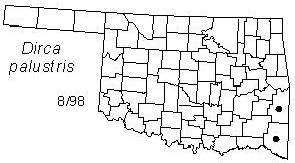Shrub, to 2 m (7 ft) tall and 10 cm (4 in) in diameter. Bark gray, tough and leathery. Twigs yellow to green, glabrous. Leaves alternate, simple, obovate to oval, 5-10 cm (2-4 in) long, 3.5-7 cm (1.4-2.8 in) wide; membranous, pubescent when young, becoming glabrous above, but remaining pubescent beneath; narrow or rounded at base, acute to subacute at apex, margin entire; petiole short, the base covering next year's bud. Flowers abundant in fascicles of 2-4 with short pedicels, 0.8-1.3 cm (0.3-0.5 in) long; calyx yellow, funnel-form, slightly constricted above the ovary; petals absent; style 1, elongate, fifliform, somewhat exceeding the stamens; stamens 8, of two lengths, exserted about the middle; flowers appear March to April. Fruits drupes, 6 mm (0.25 in), oval to oblong, red to orange; seed solitary, dark brown with streaks.
Distribution: Oklahoma, Louisiana east to Florida, north to New Brunswick and Minnesota. Uncommon in Oklahoma; limited to the Ouachita Mountains and Gulf Coastal Plain.
Habitat : wet woods and thickets.
NWI status: FACW+, OBL
Comment: Dirca refers to a mythical spring near Thebes; palustris refers to the plant's boggy or wetland habitat.
Horticulture: A slow-growing ornamental introduced into cultivation in 1750. Grows best in shaded areas with moist soil. Can be propagated by seed or layering.
Traditional uses: The twigs and bark of leatherwood are strong and pliable. Native Americans and early settlers used these materials for weaving baskets and rope.
Medicinal uses: Fruits may be narcotic. May cause dermatitis.
Distribution in Oklahoma: 
BACK
NEXT
RETURN TO INDEX
Last update: 9/10/99
 Go to Oklahoma Biological Survey Home Page
Go to Oklahoma Biological Survey Home Page
 Disclaimer
Disclaimer